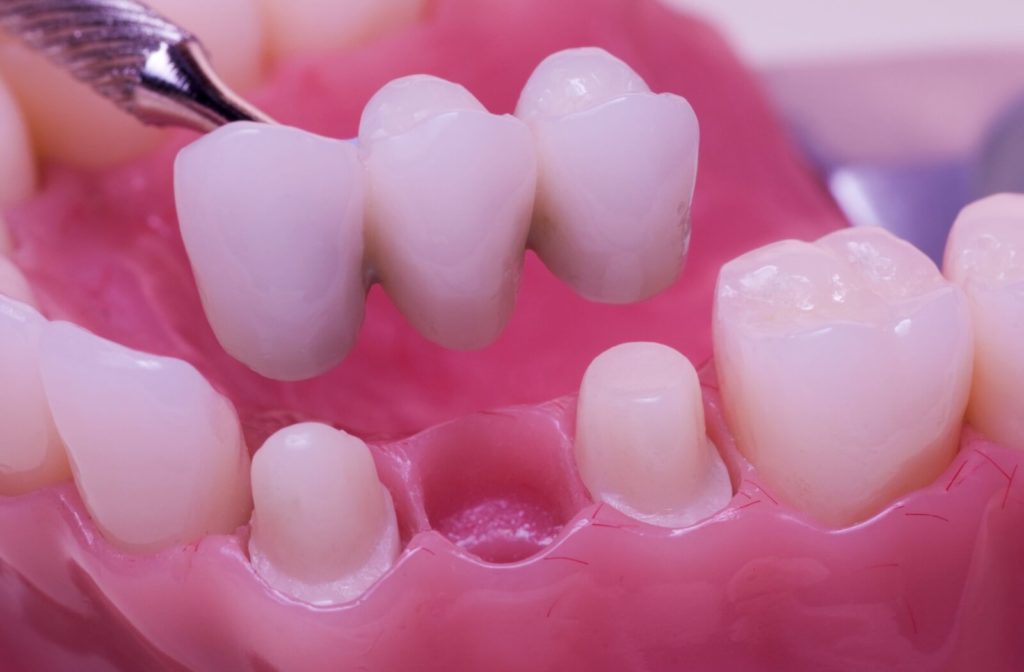Bridges and crowns are common dental restorations used to replace missing teeth or repair damaged ones. While these prosthetics can restore the functionality and aesthetics of your smile, proper oral hygiene is required to ensure their longevity and prevent complications.
Some essential oral hygiene aids are tailored for maintaining bridges and crowns. These include soft-bristled toothbrushes, interdental brushes, dental floss or floss threaders, and antimicrobial mouthwash.
Consistent dental exams and cleanings and good oral hygiene at home are crucial for protecting your bridges and crowns.
Soft-Bristled Toothbrush
Using a soft-bristled toothbrush is great for cleaning around bridges and crowns and gently removing plaque and food particles without causing damage. Firm or hard-bristle brushes can scratch the surface of the restoration and wear down the surrounding natural teeth.
How to Brush Your Teeth Properly
Step 1: Position your toothbrush at a 45-degree angle to your teeth, targeting where your gums meet your teeth. Use a gentle, circular brushing motion to massage and thoroughly cleanse this area. Be careful not to brush too hard to avoid causing your gums to recede over time.
Step 2: Make sure to brush every part of each tooth, including the biting surface, the outer surfaces near your cheeks, and the inner surfaces close to your tongue.
Step 3: Brushing shouldn’t be rushed. Aim for a thorough cleaning that lasts at least 2–3 minutes. A timer can help keep track.
Step 4: Even the most dedicated brushers can miss hidden areas in their mouth, which can happen if you consistently use the same brushing pattern. Varying your brushing pattern can help you reach those neglected areas.
Interdental Brushes
Interdental brushes are thin, cone-shaped brushes designed to clean between teeth and around dental work like bridges, crowns, and braces.
These brushes come in various sizes to fit different spaces and can effectively remove plaque from hard-to-reach areas. Incorporating interdental brushes into your oral hygiene routine can help prevent gum disease and decay around dental restorations.
Dental Floss or Floss Threaders
Flossing is an essential partner in maintaining a healthy smile. It reaches hidden nooks and crannies between teeth, bridges, and crowns, where food particles and plaque are difficult to reach. Traditional floss can sometimes be tricky to use around these dental restorations, especially for people with dexterity limitations.
Floss threaders act like needles that guide the floss between artificial teeth and natural teeth.
Water flossers use a pressurized stream of water to clean hard-to-reach areas. They can be a great option for working around bridges and crowns and for those who have limited mobility.
How to Floss Your Teeth
Step 1: Cut a piece of floss that stretches from your hand to your shoulder. Circle this floss around your index and middle fingers, ensuring you have about 2 inches of space between your hands.
Step 2: Gently guide the floss between your teeth, curving it into a “C” shape at the tooth’s base and just below the gum line. Clean the tooth by moving the floss from the bottom to the top 2 or 3 times.
Step 3: Make sure to clean both sides of each tooth, including the rear surfaces of your furthest back molars. Shift to a clean segment of floss as it becomes frayed or collects debris. Once done, dispose of the used floss by rolling it into a small ball and throwing it in the trash—never flush it down the toilet.
Step 4: Brushing your teeth post-flossing can enhance the effectiveness of your oral hygiene routine, helping to prevent cavities and gum disease.
Antimicrobial Mouthwash
An antimicrobial mouthwash can help kill bacteria in the mouth and prevent plaque buildup around bridges and crowns. An alcohol-free mouthwash specifically formulated for dental work can help avoid damaging the restorations or causing irritation to the gums. Adding mouthwash to your oral hygiene routine can provide extra protection against decay and gum disease.
Chlorhexidine Mouthwash
Your dentist may recommend a medicated mouthwash known as chlorhexidine. This mouthwash helps treat bacterial gum disease by eliminating and managing bacterial growth. Chlorhexidine can also help prevent plaque buildup and is often prescribed for those with bridges, crowns, or dental implants. It’s important to use this type of mouthwash as directed by your dentist to ensure it effectively improves oral health.
Dental Exams
Routine dental exams are essential for monitoring the health of your bridges and crowns. Your dentist can assess the integrity of the restorations, check for signs of damage or decay, and do a professional cleaning to remove stubborn plaque and tartar.
Regular visits to the dentist can help detect any issues early on and prevent complications that may arise with dental restorations.
Prioritize Your Oral Hygiene for Lasting Dental Restorations
Proper oral hygiene is essential for preserving the longevity and functionality of bridges and crowns. By incorporating these dental hygiene tools into your everyday regimen and obtaining professional care from Heritage Pointe Dental when necessary, you can ensure a healthy smile for years to come.
Remember to follow your dentist’s recommendations for caring for your dental restorations and maintaining optimal oral health—schedule your upcoming exam and cleaning appointment now!



